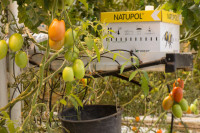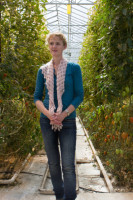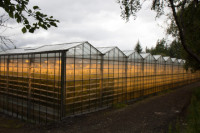Iceland: Europe’s biggest producer of bananas
They are somewhat off the tourist trail, but Iceland’s network of geothermally-heated greenhouses are an important part of their economy. I got to visit several in the Geysir/Selfoss area about an hour’s drive northeast of Reykjavik in mid July. They rely on the same hot rock system that powers the famous hot water fountains. The produce is impressive, over 90% of the nations cucumbers are produced on the island as are over 75% of the tomatoes and large proportions of peppers, and soft fruit including strawberries as well as cut flowers and bedding plants. The plants are pollinated by bees imported from the Netherlands.
The plants are pollinated by bees imported from the Netherlands.
One horticulture business run by Helena Hermundardottir pictured, and her husband and family, Fridheimar, specialises in tomatoes harvesting over 370 tonnes pa. It was established in 1995 and has 5,000 sq m under glass including a visitors centre.
and her husband and family, Fridheimar, specialises in tomatoes harvesting over 370 tonnes pa. It was established in 1995 and has 5,000 sq m under glass including a visitors centre.
The geothermal energy keeps the greenhouses at a constant 23 deg C and the long hours of daylight are used to advantage by having very thin glass roofs, just 4mm thick. Lighting is more of an issue in winter of course when the hydro-powered electricity kicks in – as indeed it does on cloudy days at other times of the year. All very hi-tech, but energy is both renewable and incredibly cheap in Iceland. Nonetheless viability is threatened by cheap imports from southern Europe, especially in winter as electricity consumption is high.
All the produce is consumed locally, no banana exports from Iceland. Bananas aren’t really a commercial crop . The University of Iceland’s Agriculture department is experimenting with growing them and current annual production is only about 120 ‘bunches’ (3-400 bananas on a ‘bunch’?) but it shows what could be done.

